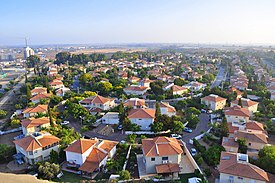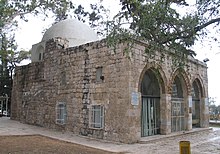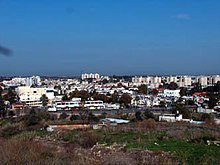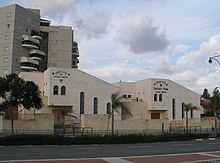Yavne
Yavne
יַבְנֶה | |
|---|---|
| Hebrew transcription(s) | |
| • ISO 259 | Yabne |
 | |
 Emblem of Yavne | |
 Yavne | |
| Coordinates: 31°53′N 34°44′E / 31.883°N 34.733°ECoordinates: 31°53′N 34°44′E / 31.883°N 34.733°E | |
| Country | |
| District | Central |
| Founded | 2000 BCE (Canaanite city) 37 BCE (Herodian rule) Islamic period (Arab village) 1949 (Israeli city) |
| Government | |
| • Mayor | Zvi Gov-Ari |
| Area | |
| • Total | 10,700 dunams (10.7 km2 or 4.1 sq mi) |
| Population (2019)[1] | |
| • Total | 47,585 |
| • Density | 4,400/km2 (12,000/sq mi) |
| Website | www |
Yavne (Hebrew: יַבְנֶה) or Yavneh is a city in the Central District of Israel. In many English translations of the Bible, it is known as Jabneh /ˈdʒæbnə/. During Greco-Roman times, it was known as Jamnia (Ancient Greek: Ἰαμνία Iamníā; Latin: Iamnia); to the Crusaders as Ibelin; and before 1948, as Yibna (Arabic: يبنى).
History[]

Yavne was one of the major ancient cities in the southern coastal plain, situated 20 km (12.43 mi) south of Jaffa, 15 km (9.32 mi) north of Ashdod, and 7 km (4.35 mi) east of the Mediterranean.[2]
Excavations were carried out on the ancient tell (mound created by accumulation of archaeological remains) known as Tel Yavne (Hebrew), which developed on a natural kurkar hill. The tell was inhabited, possibly continuously, from either the Bronze or Iron Age until the British Mandate period. During some periods, especially the Byzantine period, the settlement expanded to cover part of the plain and hills surrounding the tell.[2][3][4][5] Yavne is mentioned in the Hebrew Bible and it is documented in written sources and through archaeological excavations on the main tell and the adjacent "Temple Hill" throughout the ages.[3][5]
Yavne is considered the most significant site for post-biblical Jewish history after Jerusalem. It was here that modern Judaism was born after the destruction of Jerusalem in the year 70 CE and the loss of the Second Temple, until then the centre of religious identity for the Jews.[4] The process started in Yavne after 70 CE was essential for adapting Judaism to a new situation where there was no central Temple, in terms of laws, calendar, and liturgy, becoming the basis for Jewish religious practice throughout the world.[4]
After the destruction of the Second Temple in 70 CE, Rabban Yochanan Ben Zakkai moved the Sanhedrin to Yavne. Some scholars believe the so-called Council of Yavne met there. The Sanhedrin left Yavne for Usha in 80 CE and returned in 116 CE.[citation needed]
Bronze and Iron Age[]
Tel Yavne[]
Salvage excavations carried out in 2001 by the Israel Antiquities Authority uncovered several burials at the northern foot of the original tell. Most of the burials are dated to the later Iron Age. One burial points to a late Bronze Age occupation.
A large Philistine favissa (deposit of cultic artifacts) was discovered on Temple Hill.[3] Two excavation seasons in the 2000s led by Professor Dan Bahat revealed some Iron Age remains.[citation needed] Pottery sherds of the Iron Age and Persian period were discovered at the surface of the tell.[5]
Yavne Yam[]
The ancient harbour of Yavne has been identified on the coast at Minet Rubin (Arabic) or Yavne-Yam (Hebrew), where excavations have revealed fortification going back to the Bronze Age Hyksos.[5] It was in use from the Middle Bronze Age until the 12th century CE, when it was abandoned.[6] 2 Maccabees 12:8–9 refers to the burning of the harbour and its fleet on the direction of Judas Maccabeus.
Herodian and Roman Period[]
In Roman times, the city was known as Iamnia, also spelled Jamnia. It was bequeathed by King Herod upon his death to his sister Salome. Upon her death it passed to Emperor Augustus, who managed it as a private imperial estate, a status it was to maintain for at least a century.[7] After Salome's death, Iamnia came into the property of Livia, the future Roman empress, and then to her son Tiberius.[8]
During the First Jewish-Roman War, when the Roman army had quelled the insurrection in Galilee, the army then marched upon Iamnia and Azotus, taking both towns and stationing garrisons within them.[9] According to rabbinic tradition, Rabbi Yohanan ben Zakkai and his disciples were permitted to settle in Iamnia during the outbreak of the war, after Zakkai, realizing that Jerusalem was about to fall, sneaked out of the city and asked Vespasian, the commander of the besieging Roman forces, for the right to settle in Yavne and teach his disciples.[10][11] Upon the fall of Jerusalem, his school functioned as a re-establishment of the Sanhedrin.[12]

When disputes were rampant in Israel regarding basic halakhic norms, it was in Yavne, according to the Jerusalem Talmud (Berakhot 1:4), that a Divine voice (Hebrew: bat ḳol) was heard declaring that, while both schools of thought espoused to the words of the Living God, the Halacha, in practical matters, is in accordance with the School of Hillel. To counter a perceived threat to the emerging rabbinical authority posed by heterogeneous groups of Jews who embraced ideas that were thought to be unacceptable by the assembly, Talmudic tradition has it that it was in Yavne where Samuel the Less, during the days of Rabban Gamliel II, enacted the " twelfth benediction " in the daily prayer, known as the benediction against apostates and heretics (Hebrew: minim).[13]
Byzantine Period[]
Byzantine period finds from excavations include an aqueduct east of the tell, and a kiln.[14][15]
Early Islamic period[]
The Islamic historian al-Baladhuri (died 892 CE) mentioned Yibna as one of ten towns in Jund Filastin conquered by the Rashidun army led by 'Amr ibn al-'As in the early 7th century.[16]
In 2007, remains ranging from the Early Islamic period until the British Mandate period were uncovered.[17] An additional kiln, and part of a commercial/industrial area were uncovered at the west of the tell in 2009.[18]
Crusader, Ayyubid and Mamluk Periods[]
The Crusaders called the city Ibelin and built a castle there in 1141. Two excavation seasons led by Professor Dan Bahat starting in 2005 revealed the main gate.[citation needed] Its namesake noble family, the House of Ibelin, was important in the Kingdom of Jerusalem and later in the Kingdom of Cyprus. Salvage excavations at the west of the tell unearthed a stash of 53 Crusader coins of the 12th and 13th centuries.[18]
Benjamin of Tudela (1130–1173) identified Jamnia (Jabneh) of classical writers with the Ibelin of the Crusades. He places the ancient city of Jamnia at three parasangs from Jaffa and two from Ashdod (Azotus).[19]
Ibelin was first sacked by Saladin before his army was comprehensively routed at the Battle of Montgisard in late 1177. In August 1187, Yavne was retaken and burnt to the ground, and ceased for some time to form part of the Crusaders' kingdom.[20]
Ibelin's parish church was transformed into a mosque, to which a minaret was added during the Mamluk period in 1337. The minaret survives until today, while the mosque (the former Crusader church) was blown up by the IDF in 1950.[3][21]
Maqam Abu Hurayra, described as "one of the finest domed mausoleums in Palestine", is located in Yavne. Since the 12th century, it has been known as a tomb of Abu Hurairah, a companion (sahaba) of the Islamic prophet Muhammad.[22][23] Abu Hurairah is buried in Medina, Saudi Arabia however he was also venerated in various places in Palestine in Ramle and also in Yavne.[24] After 1948 the shrine has been adopted by Jews who came primarily from Arab countries and believe that the tomb is the burial place of Rabbi Gamaliel of Yavne.[22][23] The Jewish claimants to the site say that it was originally a Jewish sacred burial place and was Islamized later, but there is no record of Jewish pilgrimage there in the decades before 1948.[25]
Ottoman and Mandate Periods[]
For the Arab village of Yibna during the Ottoman and Mandate periods (to 1948), see Yibna. In mid-March 1948, a contingent of Iraqi soldiers moved into the village. In a Haganah reprisal on 30 March, two dozen villagers were killed. On April 21, the Iraqi village commander was arrested in Jaffa for drunkenly shooting two Arabs.[26]

Yavne 1945

Yibna 1945
State of Israel[]


During the 1948 Arab–Israeli War, residents of Zarnuqa sought refuge in Yibna, but left after the villagers accused them of being traitors.[27]
On 27 May, following the fall of Al-Qubayba and Zarnuqa, most of the population of Yibna fled to Isdud, but armed males were refused entry. On 5 June, when Israeli troops arrived, they found the village almost deserted apart from a few old people who were ordered to leave.[27]
After 1948, a number of Israeli villages were founded on Yibna land: Kfar HaNagid and Beit Gamliel in 1949, Ben Zakai in 1950, Kfar Aviv (originally: "Kfar HaYeor") in 1951, in 1955.[28] According to Walid Khalidi, a railroad crosses the village. The old mosque and minaret, together with a shrine can still be seen, and some of the old houses are inhabited by Jewish and Arab families.[citation needed]
Yavne was established in October 1948 as a transition camp for Jews from Arab countries, Iran and Europe. The first built neighbourhood was established in early 1949. In the early years, Yavne was a poor town, with the inhabitants subsisting on small-scale trade, as farm and industry laborers, and on agriculture in their yards. The town had a population of 1,600 in 1953. The town gradually developed. In the 1960s, several enterprises moved from Tel Aviv to Yavne, and industries in the city came to include leather, textiles, and metallurgy. The population had grown to 10,100 in 1970. Yavne was a stagnant backwater city until the mid-1970s, when Mayor Meir Sheetrit, who assumed office in 1974, began to develop the city as a low-density suburban satellite of Tel Aviv by building homes targeted at middle class families who could commute to Tel Aviv while living in Yavne and improving the school system. Yavne rapidly developed as a result and was granted city status in 1986. By the mid-1990s, the population had risen to 25,600.[29]
Archaeology[]
In December 2019, a large number of pottery kilns and 1,200-year-old gold coins which may have been a local potter’s “piggy bank” were unearthed in a juglet by the Israeli Antiquities Authority. According to archaeologist Robert Kool, the coins date back to the early Abbasid period, about 9th century CE. One of the seven coins was minted by Caliph Harun al-Rashid (786–809 CE). “These are gold dinars issued by the Aghlabid dynasty that ruled in North Africa. Without a doubt this is a wonderful Hanukkah present for us,” said Kool.[30][31] In August 2020, Israeli archaeologists discovered 425 complete gold coins, most dating to the Abbasid period around 1,100 years ago.[32] In April 2021, archaeologists announced the discovery of a 1,600-year-old multicolored mosaic dated back to the Byzantine period in an industrial area. According to IAA archaeologist Elie Haddad, it was the first time that excavators revealed a colored mosaic floor in Yavne.[33][34][35]
Demography[]

According to the Israel Central Bureau of Statistics (CBS), in 2001 the ethnic makeup of the city was Jewish and others, without significant Arab population. As of March 2018 the city numbered 46,705 persons, with a high percentage of young people: 36% of the population was in the 0–21 age group and 64% of the total population was younger than 39.

According to CBS figures for 2001, there were 16 schools and 7,445 students in Yavne (11 elementary schools with 4,037 students and 9 high schools with 3,408 students). 59.6% of 12th graders were entitled to a matriculation certificate that year.
Economy[]
Major companies based in Yavne include Ormat Industries, Aeronautics Defense Systems, Avisar and Orbotech. In 2019, Merck established an incubator in Yavne with a budget of about €20 million over three years that will invest in startups focusing on semiconductor and display crystal technologies.[36]
Environmental issues[]
In 2012 a new green neighborhood "Neot Rabin" was inaugurated in the south of the city.[37]
Sports[]
Maccabi Yavne is the city's major football club. During the 1980s the club played in the top division and in 1985 won the Toto Cup. Today they are in Liga Leumit. The basketball team, Elitzur Yavne, have also played in the Liga Leumit (basketball) since 2007.
Omri Casspi, the first Israeli to play in the National Basketball Association, grew up in the city and played for some of its teams.
Notable residents[]
- Avior Byron (born 1973), singer, songwriter, and musicologist
- Omri Casspi (born 1988), Israeli professional NBA basketball player
- Itai Chammah (born 1985), Olympic swimmer
- Gil Dor, guitar player
- Elishay Kadir (born 1987), basketball player
- Uri Kokia (born 1981), basketball player and coach
- Shlomi Koriat (born 1976), actor and comedian
- Maor Melikson, footballer
- Nevo Mizrahi (born 1987), footballer
- Mushail Mushailov, artist
- Ido Nehoshtan, Major-General (ret.), former chief of Israeli Air Force
- Shabak Samech, rap and hip-hop group
- Meir Sheetrit (born 1948), Israeli Minister of the Interior
Sister cities[]
Yavne is twinned with:
 Le Raincy, France
Le Raincy, France Speyer, Germany
Speyer, Germany Sunrise, Florida, United States
Sunrise, Florida, United States
See also[]
- Yavne-Yam
- Economy of Israel
- Archaeology of Israel
References[]
- ^ "Population in the Localities 2019" (XLS). Israel Central Bureau of Statistics. Retrieved 16 August 2020.
- ^ Jump up to: a b Moshe Fischer, Itamar Taxel and David Amit, Rural Settlement in the Vicinity of Yavneh in the Byzantine Period: A Religio-Archaeological Perspective, Bulletin of the American Schools of Oriental Research, No. 350 (May, 2008), pp. 7-35.
- ^ Jump up to: a b c d Raz Kletter, Irit Ziffer, Wolfgang Zwickel. "Yavneh I: The Excavation of the 'Temple Hill' Repository Pit and the Cult Stands." Orbis Biblicus et Orientalis, Series Archaeologica (OBOSA), Book 30. Academic Press Fribourg, Switzerland (ISBN 978-3-7278-1667-3) and Vandenhoeck & Ruprecht, Göttingen (ISBN 978-3-525-54361-0). 2010. Pages 2-13 [1]
- ^ Jump up to: a b c [Press release of the Israeli Ministry of Foreign Affairs, 2005-2006 http://www.mfa.gov.il/mfa/israelexperience/history/pages/archaeological%20excavations%20in%20israel%202006.aspx
- ^ Jump up to: a b c d Avraham Negev and Shimon Gibson (2001). Jabneh; Jabneel; Jamnia (a). Archaeological Encyclopedia of the Holy Land. New York and London: Continuum. p. 253. ISBN 0-8264-1316-1.
- ^ "Archeology in Israel - Yavne Yam".
- ^ Kletter, Raz (2004). "Tel Yavne". Excavations and Surveys in Israel. 116. Retrieved 2017-12-31.
- ^ "Jabneh". www.jewishvirtuallibrary.org.
- ^ Josephus, The Jewish War 4.3.2 (4.130)
- ^ Nathan ha-Bavli (1976). Shemuel Yerushalmi (ed.). Avot de-Rabbi Natan (in Hebrew). Jerusalem: Mekhon Masoret. p. 29 (chapter 4, section 5). OCLC 232936057.
- ^ Ben-Israel, Uriah (1979). "Yavne". In Alon, David (ed.). Israel Guide - Sharon, Southern Coastal Plain and Northern Negev (A useful encyclopedia for the knowledge of the country) (in Hebrew). 6. Jerusalem: Keter Publishing House. p. 132. OCLC 745203905.
- ^ Babylonian Talmud, Gittin 56b
- ^ Eisenstein, J.D., ed. (1935), "יבנה", Ozar Yisrael - An Encyclopedia of all matters concerning Jews and Judaism, in Hebrew (in Hebrew), 5, London: Shapiro, p. 48, OCLC 917796525; cf. Babylonian Talmud, Berakhot 28b
- ^ Velednizki, Noy (2004). "Yavne Final Report". Excavations and Surveys in Israel. 116. Archived from the original on 2011-07-19. Retrieved 2010-08-08.
- ^ Sion, Ofer (2005). "Yavne Final Report". Excavations and Surveys in Israel. 117. Retrieved 2017-12-31.
- ^ [Bil. 138, quoted in Le Strange, 1890, p. 28 https://archive.org/stream/palestineundermo00lestuoft#page/28/mode/1up]
- ^ Volynsky, Felix (2009). "Tel Yavne Final Report". Excavations and Surveys in Israel. 121. Retrieved 2017-12-31.
- ^ Jump up to: a b Shimron, Ilanit (2009-04-06). מטמון נדיר נמצא בחפירות ארכיאולוגיות בתל יבנה [Rare Treasure Found in Excavations at Tel Yavne] (in Hebrew). Ynet. Retrieved 2010-08-08.
- ^ The Jewish Encyclopedia (1906), s.v. Jabneh
- ^ M Fischer and I Taxel, https://www.researchgate.net/profile/Itamar_Taxel/publication/307577653_Fischer_M_and_Taxel_I_2007_Ancient_Yavneh_Its_History_and_Archaeology_Tel_Aviv_34_204-284/links/57c9b13708ae59825180f324/Fischer-M-and-Taxel-I-2007-Ancient-Yavneh-Its-History-and-Archaeology-Tel-Aviv-34-204-284.pdf 'Ancient Yavneh: Its History and Archaeology,' Journal of the Institute of Archaeology of Tel Aviv University· December 2007 vol. 34: No 2, pp.204-284 p.247
- ^ Denys Pringle (1998). Yibna: Church (No. 280). The Churches of the Crusader Kingdom of Jerusalem: A Corpus: Volume 2, L-Z (excluding Tyre). Cambridge University Press. pp. 379–380. ISBN 9780521390378. Retrieved 24 January 2016.
- ^ Jump up to: a b Mayer et al., (1950:22) Cited in Petersen, Andrew (2002). A Gazetteer of Buildings in Muslim Palestine: Volume I (British Academy Monographs in Archaeology). Oxford University Press. p. 313. ISBN 978-0-19-727011-0.
- ^ Jump up to: a b Doron Bar (2009). "Mizrahim and the development of sacred space in the State of Israel, 1948–1968". Journal of Modern Jewish Studies. 8 (3): 267–285. doi:10.1080/14725880903262988. S2CID 145291702.
- ^ Baer, Eva (11 December 1989). Ayyubid Metalwork With Christian Images. BRILL. ISBN 9004089624 – via Google Books.
- ^ Gideon Bar (2008). "Reconstructing the past: The creation of Jewish sacred space in the State of Israel, 1948–1967". Israel Studies. 13 (3): 1–21. doi:10.2979/ISR.2008.13.3.1. S2CID 144598350.
- ^ Morris, Benny (2004). The Birth of the Palestinian Refugee Problem Revisited. Cambridge: Cambridge University Press. p. 259. ISBN 9780521009676.
- ^ Jump up to: a b Morris, Benny (2004). The Birth of the Palestinian Refugee Problem Revisited. Cambridge: Cambridge University Press. pp. 258–259. ISBN 9780521009676.
- ^ Khalidi, 1992, p. 423
- ^ Machline, Elise; Pearlmutter, David; Schwartz, Moshe; Pech, Pierre (25 April 2020). Green Neighbourhoods and Eco-gentrification: A Tale of Two Countries. ISBN 9783030380366.
- ^ "Archaeologists find hoard of Islamic coins in Israel: 'It's like a Hanukkah present'". Haaretz.com. Retrieved 2020-08-08.
- ^ "Trove of 1,200-year-old 'Arabian Nights' gold coins uncovered in Israel". The Jerusalem Post | JPost.com. Retrieved 2020-08-08.
- ^ "Youth volunteers uncover hundreds of ancient gold coins in Israel". CBC News. Retrieved 2020-08-08.
- ^ Jack Guy. "Archaeologists uncover 1,600-year-old mosaic in Israel". CNN. Retrieved 2021-05-04.
- ^ staff, T. O. I. "1,600-year-old multicolored mosaic with geometric motifs uncovered in Yavne". www.timesofisrael.com. Retrieved 2021-05-04.
- ^ Gershon, Livia. "Colorful, 1,600-Year-Old Mosaic Adorned With Geometric Patterns Found in Israel". Smithsonian Magazine. Retrieved 2021-05-04.
- ^ Solomon, Shoshanna. "German drugmaker Merck sets up Israel incubator to tap into chip, sensor tech". www.timesofisrael.com.
- ^ "פינוי אשפה פנאומאטי - צעד ירוק למען הסביבה ביבנה והסביבה - פורטל יבנה שלי". www.myavne.co.il.
External links[]
| Wikimedia Commons has media related to Yavne. |
- Municipal website
 Singer, Isidore; et al., eds. (1901–1906). "Jabneh". The Jewish Encyclopedia. New York: Funk & Wagnalls.
Singer, Isidore; et al., eds. (1901–1906). "Jabneh". The Jewish Encyclopedia. New York: Funk & Wagnalls.- Yavneh Yields Over a Hundred Philistine Cult Stands Biblical Archaeology Review
- . Encyclopædia Britannica (11th ed.). 1911.
- Central District (Israel)
- Yavne
- Cities in Central District (Israel)
- Cities in Israel
- Development towns
- Hebrew Bible cities
- Talmud places
- Ancient Jewish settlements of Judaea
- Canaanite cities
- Tells (archaeology)
- 1949 establishments in Israel





